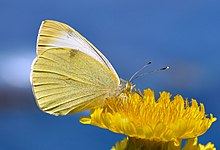Canary Whiteling
| Canary Whiteling | ||||||||||||
|---|---|---|---|---|---|---|---|---|---|---|---|---|

Canary Whites ( Pieris cheiranthi ) |
||||||||||||
| Systematics | ||||||||||||
|
||||||||||||
| Scientific name | ||||||||||||
| Pieris cheiranthi | ||||||||||||
| ( Huebner , 1808) |
The Canary Whites ( Pieris cheiranthi ) is a butterfly ( butterfly ) from the family of the whiteflies (Pieridae).
features
The moth is very similar to the great cabbage white butterfly ( Pieris brassicae ), but the discal spots are larger and fused together. It reaches a size of 57 to 66 millimeters.
Subspecies
- Pieris cheiranthi cheiranthi (Hübner, 1808)
- Pieris cheiranthi benchoavensis Pinker, 1969, La Palma ( Canary Islands )
distribution
The Canary Whites is widespread on La Palma , on Tenerife it is restricted to the northern coastal areas. The last record of La Gomera comes from 1975 , where the species is probably extinct. There are also unconfirmed reports from Gran Canaria , while a report from Lanzarote is an incorrect determination. The closely related Madeira whitefly occurred on Madeira . On the other hand, the widespread Great Cabbage White ( Pieris brassicae ) flies in the Azores .
The Canary Whites inhabit wet, damp, shady ravines in laurel forests . Outside the laurel forest zone, for example, wet cliffs with a corresponding microclimate come into consideration.
Way of life
The female moths lay the eggs on the underside of the leaf in piles of 5 to 50 pieces. The predators have a light green basic color and are dotted with black. On the top and sides they show a light yellow stripe. The food plants of the caterpillars include cruciferous vegetables , such as the Canary Island Silverweed ( Lobularia canariensis ) or nasturtiums ( Tropaeolum majus ). The slender sea kale ( Crambe strigosa ), which is endemic to the Canary Islands, appears to be the only natural food crop.
Flight and caterpillar times
The species flies in seven to eight successive generations, some of which overlap. The moth appears all year round, a diapause is not known.
Hazard and protection
The Canary Whites is one of the endangered species due to the progressive loss of habitat , in some localities it has already become extinct within the last 20 years. The causes are primarily to be found in the reduction in its range through human influence, but possibly also through the introduction of pathogens or parasites. Measures to preserve the species consist primarily in the preservation and protection of the wet, moist laurel forests .
- IUCN : Endangered
swell
Individual evidence
- ↑ Tom Tolman, Richard Lewington: The butterflies of Europe and Northwest Africa. Franckh-Kosmos Verlags-GmbH & Co, Stuttgart 1998, ISBN 3-440-07573-7 .
- ^ Pieris wollastoni (BUTLER, 1886). Heiner Ziegler: www.euroleps.ch, accessed on December 4, 2013 .
- ↑ Pieris brassicae (LINNAEUS, 1758). Heiner Ziegler: www.euroleps.ch, accessed on December 4, 2013 .
- ↑ Lozan et al. DNA-based confirmation that the parasitic wasp Cotesia glomerata (Braconidae, Hymenoptera) is a new threat to endemic butterflies of the Canary Islands. - Conservation Genetics 2007 9 (6): 1431 to 1437
- ↑ Pieris cheiranthi in the endangered Red List species the IUCN 2010. Posted by: CAM Van Swaay et al, 2009. Accessed on 05/03/2011..
literature
- M. Wiemers: The butterflies of the Canary Islands. A survey of their distribution, biology and ecology (Lepidoptera: Papilionoidea and Hesperioidea). First part. Linneana Belgica 1995 15: 63-86 pdf
Web links
- www.schmetterling-raupe.de
- Moths and Butterflies of Europe and North Africa (English)
- www.butterfly-guide.co.uk (English)
- Fauna Europaea - Taxonomy
